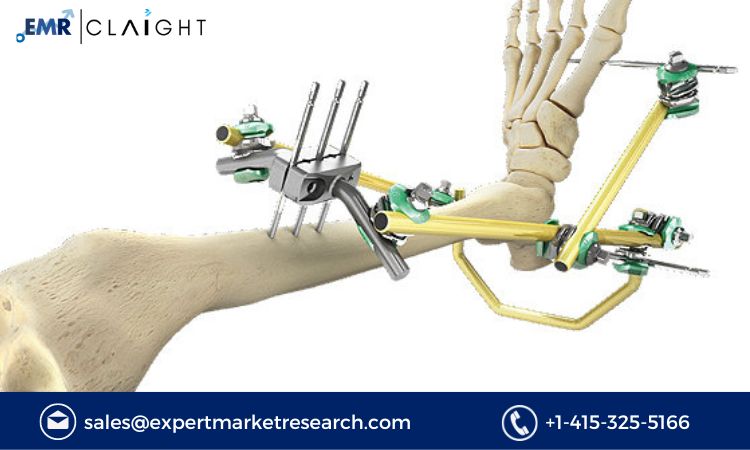Fracture Fixation Products Market Analysis, Size, Trends (2024-2032)

Strong 8k brings an ultra-HD IPTV experience to your living room and your pocket.
Fracture fixation products are essential tools in orthopedic surgery, designed to stabilize and support the healing of broken bones. As of 2023, the market's valuation stood at USD 15.22 billion, driven by an array of factors including demographic shifts, technological advancements, and evolving healthcare practices. This report aims to dissect these dynamics, offering a granular analysis of the market's trajectory from 2024 to 2032, alongside an exploration of the innovations and strategies shaping its future.
Market Overview
Projected to expand at a CAGR of 9.5%, the market is expected to reach USD 34.45 billion by 2032. This growth is underpinned by several factors:
Increasing Incidences of Osteoporosis: The rise in osteoporosis cases worldwide escalates the demand for effective fracture management solutions.
Enhanced Healthcare Facilities: Investments in healthcare infrastructure, particularly in emerging economies, facilitate wider access to fracture fixation procedures.
Aging Population: The global increase in the elderly population, who are more susceptible to fractures, significantly contributes to market growth.
Government Initiatives: Increased healthcare expenditure and supportive policies by governments worldwide bolster market expansion.
Challenges such as the high cost of surgeries and potential complications, alongside the impact of the COVID-19 pandemic, have also shaped market dynamics, pushing for innovations in telehealth and minimally invasive procedures.
Market Segmentation
By Product Type
Internal fixators, including plates, screws, and nails, are preferred for their stability and effectiveness in complex fractures. External fixators find their niche in temporary stabilization and cases requiring minimal surgical intervention.
By Material
Metallic fixators have been the mainstay due to their strength and reliability. However, bioabsorbable fixators are gaining traction, offering the advantage of not requiring surgical removal post-healing.
By End-User
Hospitals remain the primary setting for fracture fixation procedures due to their comprehensive facilities. Orthopedic clinics and ambulatory surgical centers are becoming increasingly popular due to their cost-efficiency and convenience.
By Geography
The North American market leads due to its advanced healthcare system and high patient awareness. The Asia-Pacific region is witnessing rapid growth, driven by improving healthcare infrastructure and rising healthcare spending.
Competitive Landscape
The market is characterized by intense competition among key players such as B. Braun Melsungen AG, Johnson & Johnson, Smith & Nephew, Stryker Corp., and Zimmer Biomet Holdings. These entities focus on innovation, mergers & acquisitions, and geographic expansion to consolidate their market positions. For instance, companies are increasingly investing in R&D to develop smart implants and biocompatible materials that enhance healing and patient comfort.
Regulatory and Reimbursement Scenario
Regulatory frameworks ensure the safety and efficacy of fracture fixation products, with stringent approval processes in place across different regions. The reimbursement landscape significantly influences market dynamics, as coverage policies affect the affordability and accessibility of treatments.
Technological Advancements
Innovations such as 3D printing, smart implants, and minimally invasive surgical techniques are revolutionizing fracture management. These advancements not only improve surgical outcomes but also reduce hospital stays and recovery times, enhancing patient quality of life.
Market Trends and Future Outlook
Emerging trends include the integration of AI and robotics in surgical procedures, personalized medicine approaches for tailored treatment plans, and the use of biologics to accelerate bone healing. The market's future will be shaped by the ability of players to leverage these trends, addressing the growing demand for advanced and efficient fracture fixation solutions.
Challenges to Market Growth
High costs associated with advanced fixation products and surgeries remain a significant barrier, particularly in low- and middle-income countries. Moreover, surgical risks and the potential for complications necessitate ongoing research and development to enhance safety and efficacy.
FAQ: Fracture Fixation Products Market
What are fracture fixation products?
Fracture fixation products are medical devices designed to stabilize and support bones to ensure proper alignment and healing after a fracture. They include a variety of internal and external devices like plates, screws, nails, pins, wires, and external fixators.
Who needs fracture fixation?
Patients who have suffered bone fractures that cannot be treated with casting alone may require fracture fixation. This includes individuals with complex fractures, fractures in certain locations that are prone to healing poorly, or patients whose lifestyle or medical conditions necessitate quicker recovery.
How has the fracture fixation products market evolved?
The market has evolved significantly with advancements in materials science, biomechanics, and surgical techniques. From the use of simple metal plates and screws to the development of bioabsorbable materials and minimally invasive surgical procedures, the field has seen substantial innovation aimed at improving patient outcomes and recovery times.
What are the latest trends in fracture fixation technology?
Recent trends include the use of 3D printing to create custom implants tailored to the specific anatomy of patients, the development of smart implants that can monitor the healing process, and the integration of biocompatible and bioabsorbable materials that support bone growth while reducing the need for secondary surgeries.
How do regulatory policies affect the fracture fixation products market?
Regulatory policies ensure the safety and efficacy of fracture fixation products. Manufacturers must comply with stringent testing and approval processes before their products can be marketed. These regulations can vary significantly between regions, affecting the availability of certain devices and technologies in different parts of the world.
What challenges do patients face with fracture fixation?
Patients may face challenges such as the risk of infection, the possibility of delayed bone healing or nonunion, and the need for additional surgeries to remove or adjust fixation devices. Advances in surgical techniques and device materials aim to minimize these risks.
Media Contact:
Company Name: Claight Corporation
Contact Person: Joe Goldberg, Business Consultant
Email: [email protected]
Toll-Free Number: US +1-415-325-5166 | UK +44-702-402-5790
Address: 30 North Gould Street, Sheridan, WY 82801, USA
Note: IndiBlogHub features both user-submitted and editorial content. We do not verify third-party contributions. Read our Disclaimer and Privacy Policyfor details.


